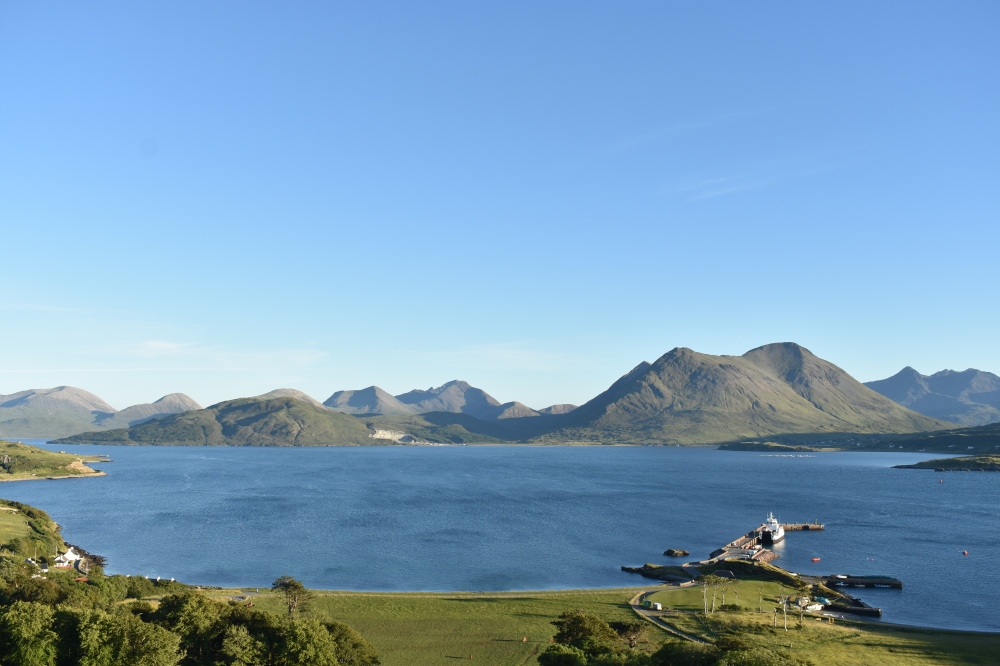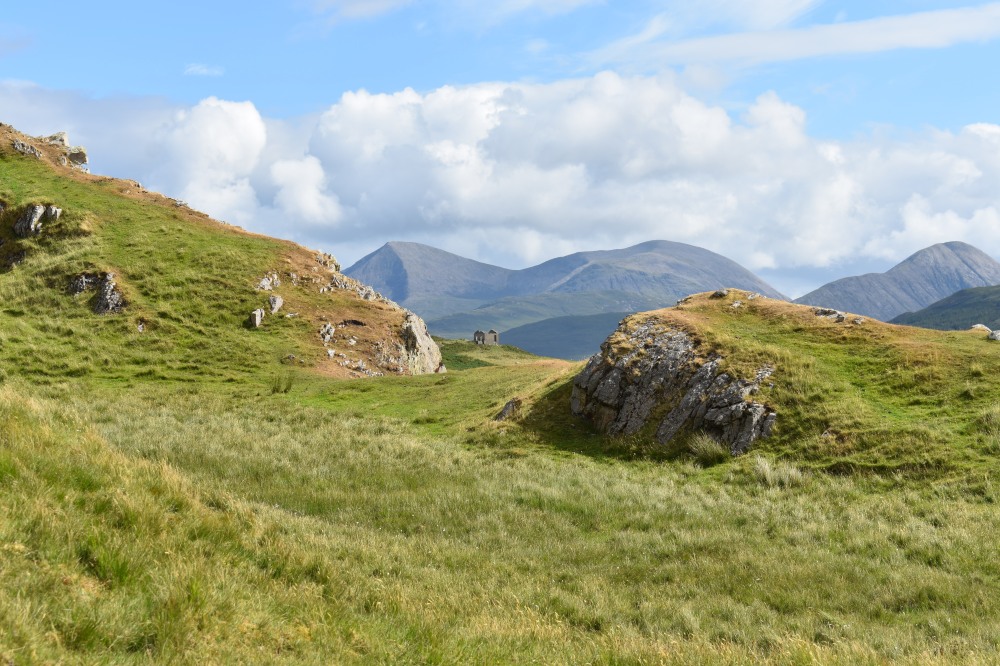What forms in the mind when you hear the name Raasay? Perhaps a remembrance of the mention of the name, the claims of heritage that your family has separated from a time long ago, or merely an indifferent opinion about a place you have never heard of? For me even hearing the muffled whispered utterance of Raasay floods my mind with a plethora of emotions, beauty and nostalgia. The mesmerising mountains of the neighbouring island of Skye, the deep and muddled history it boasts, and the people and its land, all make me feel blessed to call it my home.
At around 13 miles long and three miles across at its widest point, Raasay is a small island. However, Raasay’s size only adds to the unique charm that the island offers. Anywhere you walk you are presented with gorgeous, jaw-dropping views. Once you fully experience the island you can’t help but feel certain that you have discovered the Garden of Eden itself.



Now as beautiful as Raasay is, it holds deep scars within it that are thankfully now beginning to heal. It has a long and, at many times, dark history, most of this stemming from cruel or, at best, apathetic landlords. Landlords who didn’t see that the islanders and Raasay were not separate but just two parts of a whole, a harmony that had been cemented through generations and generations of living on the island. Instead, these landlords saw the people of Raasay as a “hindrance” to any profit. So, this “hindrance” was told to leave behind the land that had been beneath their family’s feet from time immemorial, and if they refused they were forcibly made to leave.
So began the long period that was a crushing weight on the people of Raasay. Although each landlord would either sell off the island or pass away, it didn’t stop the cultural genocide that took place on the island, and on many other islands and lands throughout the highlands and islands of Scotland. The Highland Clearances, as these actions became known, would forever change the land, people and culture that they affected. You can still see the effect of the clearances on the island. One such place is one of my favourite walks on the island: Hallaig.
On this walk you see the mesmerising views of the east coast of Raasay, but also the sorrow filled ruins of its past. As the walk starts to come to its fruition you will come across a memorial cairn to the people of Hallaig, and on that you will find a poem by native and famous poet Sorley MacLean entitled “Hallaig”. The poem talks about the damage and impact the clearances had. You can choose to end your walk here or carry on the path to see the abandoned township of Hallaig.

Throughout Raasay’s history, people had settled in Hallaig and one can only think that there could still have been people living there today if not for the Highland Clearances. By the time it was over Hallaig’s population had dropped from 127 to six. There is an eerie sense as you walk, touch, and see the abandoned township. All that is left of the centuries of lives people had in Hallaig is ruins. If you close your eyes you can listen to the swishing of the wind in the grass, the crashing of the sea on the shore and the calls of the birds soaring in the sky. If you take them away, is silence all that is left? Or can you faintly hear the sound of children playing in the bracken, the men tending to their croft, and the sound of a crackling fire in the hearth that keeps the family warm?
Although Raasay has seen its fair share of troubles, a revival has gripped the island. What was once in the hands of tyrannical landlords is now under the control of the people of Raasay. The community owns much of the infrastructure on the island, including the only shop “Raasay Stores”, the community hall where the people of Raasay gather to rejoice in such activities as ceilidhs (traditional dances), and the manor where many of these landlords once lived, Raasay House.
As you arrive on the island you will spot the Georgian mansion, Raasay House, once the seat of power for the MacLeods of Raasay, and thereafter for other landlords of the island. After being derelict for too long it is now a hotel and activity centre and also has hostel rooms. Although hampered in 2010 by a fire that devastated the building, at the risk of sounding clichéd, Raasay House has risen from the ashes. It is a popular destination for both tourists and locals who come to stay, socialise in the bar, or eat in its restaurant. I can’t help but find it poetic irony that in a place that used to be the home for those who leached from the island and its people now houses the people who come to visit our beautiful island and culture.
Even more recent is the first legal distillery on the island. Having only been built in 2017, the Isle of Raasay Distillery has already become a staple of the island, employing a lot of the local population (including myself), increasing tourism, and generally adding to the already rich culture of our island. Arguably boasting one of the best views of any Scottish distillery, it is focussed on creating the best whisky that it can, adding a personal touch to the whisky it hopes to create, something that will be as much a part of the island as its people. You can also stay at the hotel in the distillery: Borodale House.
Borodale House is a late Victorian building that was built as the house for the factor (estate manager) of the Raasay estate, but it now acts as the distillery hotel where you can enjoy your stay with fantastic views, while sipping a dram and relaxing in the majesty and peacefulness of Raasay. Borodale House is also a property that was once used by those who held the island in a vice-like grip, bleeding it of the culture and people who were as much a part of the island as the heather on its hills. Now it is used to accommodate people who come to witness all that Raasay has to offer.
Throughout my short life Raasay has seen its fair share of changes: new people moving to the island, new business being built, and an increase in tourism. It is both terrifying and fascinating to imagine what changes are to come to the island. A small part of me fears having as many tourists as midges, which the likes of Skye seems to get these days. I love Raasay for its quaintness and remoteness. When you are on Raasay you do feel, to a certain extent, secluded from the outside world. It is something that is indescribably beautiful, to exist, even for a parting second, in that bubble staring at the red hued sunset that the Cuillin of Skye so love without a care in a world and at one with nature.




However, I would be a fool not to see that tourism is here now and will continue to be the life force of the island. And it is the staples of the island like the distillery and Raasay House that will allow this life force to continue, offering the opportunity for more jobs on the island, more tourism, and generally giving back instead of taking away, on an island that is page after page of sorrow and exploitation in a beaten and tragic book.
So, enjoy your stay on Raasay and know that, by merely coming to our island, enjoying our breathtaking views and becoming engrossed in our culture, you are helping to sustain the very things you are delighting in. It is the era of Raasay’s renascence. What the clearances and nonchalant landlords brought has begun to be undone, the people of Raasay have taken back the island and welcome all to come and enjoy the beautiful Island we call home.






What a good read, we have visited Raasay 3 times staying in Pip’s cottage by the shore, we loved every minute. The remoteness and the scenery are breath taking, the forests are lovely ( sadly blighted on our last visit by enforced clearing due to disease). The minute we step of the ferry we feel at ‘home’. Beautiful place with equally beautiful people. ( Especially Ann and Donnie O ) We hope Raasay continues to thrive but doesn’t lose its soul, its peace and tranquility.
LikeLiked by 1 person
Yes, it’s beautiful and where my roots lie.
LikeLiked by 1 person
It made me very nostalgic as a child of raasay.it was beautifully presented
LikeLiked by 1 person
Thank you, I’m just glad I can do the island some justice.
LikeLike
Beautiful! Home is where the heart is they say and that is why Raasay has been and always will be home to me. It is where my family are and have been since tme immemorial.
LikeLiked by 1 person
What a great article, beautiful sentiments and photographs. My partner and I visited Raasay for the first time this Summer (staying in Balmeanach) and have fallen in love with the island, its wildlife, history and community and cannot wait to visit again, walk the island coast and listen to the silence. In a tiny way, as occasional visiting tourists, we hope to support the islanders (not least at the fabulous community store). We are grateful for the opportunity to have a taste of this beautiful island life. Thank you.
LikeLiked by 1 person